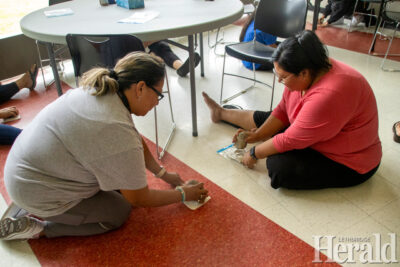Residents learn about the history of pemmican
By Alexandra Noad - Lethbridge Herald Local Journalism Initiative Reporter on July 20, 2024.
 Herald photo by Alexandra Noad -
Participants crush up dried meat with rocks as part of a pemmican making workshop this week at the Blackfoot Resource Hub.
Herald photo by Alexandra Noad -
Participants crush up dried meat with rocks as part of a pemmican making workshop this week at the Blackfoot Resource Hub.When the buffalo roamed the land which is now known as Canada, the Blackfoot people relied on it for all of their basic needs. A single buffalo could produce up to 500 pounds of meat.
Without fridges to keep the meat cold how were they able to utilize it to nourish their bodies?
The answer to this question is pemmican. Pemmican is a traditional food from ancient Indigenous culture. While each tribe used meat native to their areas, the Blackfoot people used primarily buffalo meat. The three components to pemmican were meat, fat and berries. Each component played a vital role in both nutrition and preservation.
The meat was first dried, this was not only to preserve the meat, but it also made it much lighter to pack as the Blackfoot people travelled the lands.
The berries, often Saskatoon berries or choke cherries were used. These provided the people with essential vitamins and antioxidants for the people. They were also dried for preservation. The last component to pemmican is fat.
Traditionally Indigenous people would use the fat from the same animal as the meat to prevent waste. The fat was rendered by boiling it in water to separate any contaminates. Fat not only made a airtight seal for the pemmican, it also provided the people with energy they would need to travel by foot as they did not have horses until the White settlers came.
The process of making pemmican was a strenuous one. Once the meat was dried it would be put on a rock and finely ground with another rock into a powder-like consistency. This ensured not only that the meat was dried, but also the fat could coat the entirety of the meat to preserve it. Once the meat was ground up, the fat was poured on to coat the meat.
Historically, a lot of fat was used in pemmican so they resembled patties. Once the fat was mixed the dried berries were mixed in.
While the history of pemmican goes back centuries, it is still enjoyed today.
On Thursday, members of the community had the opportunity to learn about the history of pemmican while making their own batch from Charlie Russell at the Blackfoot Resource Hub.
Russell has been making pemmican since 2016 as a side hustle to help get him through college. He says everyone can benefit from learning from Blackfoot traditions as they used food native to the land.
“Our cultural food is derived from the land. So everybody lives here on Blackfoot territory. All the ingredients come naturally from this territory so, it’s really important for everybody to understand what benefits this area provides to everybody. And consuming healthy foods isn’t just for Indigenous people, it benefits everybody as a whole” said Russell.
The pemmican the community made contained 350 calories and 25 grams of protein, making it a sustainable meal option for people on the go.
The Blackfoot Resource Hub hosts several informative events on Blackfoot culture. Information on future events can be found on their Facebook Page.
15-14


